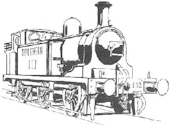 |
|
|
| Newsletter - August 2003 The appeal has continued to grow slowly and is now approaching £6,000. Part of the income comes from donations in the workshop viewing gallery collecting box but unfortunately as a result of the shed being closed to the public this source of income has dried up. However, the Driver for a Fiver days have again been very popular. Despite priority continuing on 30075, a great deal of progress has been achieved on the E1 over the last few months. The horn guide bolt replacement and painting of the frames has been completed and the springs have all been repaired with new buckles and refitted to the loco. Below is loco owner Dick Bellchambers working between the frames greasing a small end bearing. The other picture is of two springs with repaired buckles painted with primer.
Since the loco was to be moved outside, the job of machining the valve faces needed to be completed. The valve seat cutting machine had been modified last year to be driven automatically by compressed air. The cutting method was also changed to be achieved by use of coarse wet and dry sandpaper, lubricated with paraffin, instead of a cutting tool. The paper was carried on two plates, separated by adjustable springs to enable machining of both valve faces simultaneously. This gave much better control of the depth of cut. The process of machining the faces was quite slow taking several days to complete, but since the machine could be left running on its own this did not matter - except to other occupants of the workshop who had to put up with the noise! The results were good with a big improvement in the flatness of the faces being achieved. The final test will come though, when the loco is run and we will see if the annoying oscillating action has been cured. Refitting the springs meant that the loco could be taken off the jacks and made mobile once again. It has now been taken out of the workshop to enable 30075 to be brought in and worked on. The pictures below show Jeff at work with the gas axe removing the worn spring tops ready for the new ones to be welded back on. Marc is using the mill machining a set of spacers to locate the horn stays to the bottom of the horn guides. These will replace the inadequate wooden ones that were previously fitted.
Progress on the boiler has moved ahead rapidly thanks to the dedicated team of volunteers. Much of the work currently being undertaken, being of a heavy and highly skilled nature, is usually entrusted to a specialised boiler contractor. However, it was felt that, providing the volunteer effort was available, most tasks were within our capability and it was therefore decided to do as much as possible of the work ourselves. Replacement of the stays involves a great deal of work - after drilling and chiselling out the stay, each hole has to be drilled out, quite often a previous repair ground back then built up with weld, dressed with a burr, reamed and finally tapped to form the new thread. A new, purpose made, stay tap was purchased for the job. The whole process has to be repeated over 300 times since that is the number of side stays being replaced. Each hole has also been subjected to a magnetic particle inspection to detect the presence of star cracks radiating from the hole. A small number of cracks were found which were subsequently repaired by welding. The crack detection was carried out by a specialist contractor OIS ltd who has the necessary equipment. They also conducted an ultrasonic thickness test which showed that the boiler plates were not significantly thinned or grooved anywhere. New steel stays were purchased and arrived just as the last holes had been tapped. The stays were screwed into place and made water tight by caulking with an air powered tool. The stay heads are riveted over on this boiler, a process which involves heating the stay head to a bright orange and hammering down with a heavy, air riveting tool. Like a lot of work on the boiler this involves a great deal of noise! Work currently in hand includes finishing off the side stay riveting, removing the crown stays and refurbishing the crown sheet holes. The new front tube plate and crown stays are also on order. Following the boiler retube completed earlier in the year, 5637 was back in the workshops a few weeks later for repairs to a crack in the backhead. After grinding out the crack, a coded welder was hired to undertake the weld repair. The loco was out of traffic for 3 weeks while the repair was carried out, but otherwise it has continued to be a reliable performer.
|